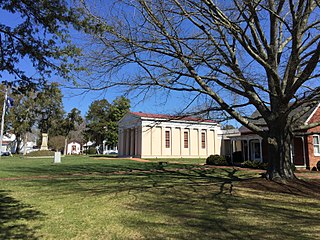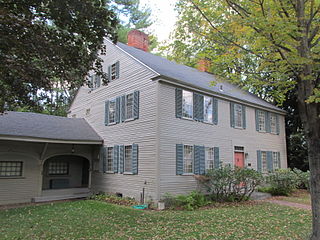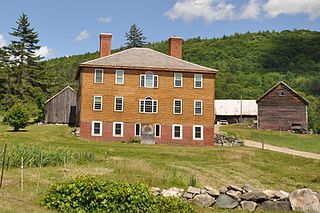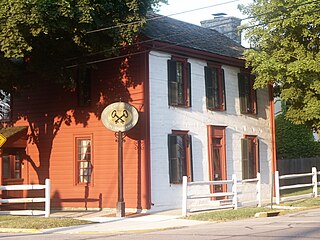
Powhatan County is a county located in the Commonwealth of Virginia. As of the 2010 census, the population was 28,046. Its county seat is Powhatan.

Cumberland County is a county located in the Commonwealth of Virginia, United States. As of the 2010 census, the population was 10,052. Its county seat is Cumberland.

Buildings, sites, districts, and objects in Virginia listed on the National Register of Historic Places:

Powhatan is a census-designated place in and the county seat of Powhatan County, Virginia, United States. Powhatan was initially known as Scottville, and historically has also been known as Powhatan Court House and Powhatan Courthouse. It is named after Chief Powhatan, father of Matoaka (Pocahontas).

Hanover County Courthouse is a historic courthouse located in the community of Hanover Courthouse, the county seat of Hanover County, Virginia. Built about 1735, it is one of the nation's oldest courthouses still in use for that purpose. It is historically notable as the site of the Parson's Cause case, which was argued by Patrick Henry in 1763. It was designated a National Historic Landmark in 1973. A modern courthouse complex stands nearby, which now houses most of the county's judicial functions.

The Clover Hill Tavern with its guest house and slave quarters are structures within the Appomattox Court House National Historical Park. They were registered in the National Park Service's database of Official Structures on October 15, 1966.
Littleberry C. Mosby Jr. was an American military officer. During the American Revolutionary War, he served in the Continental Army as a captain in the 2nd Georgia Regiment, and was captured at the Siege of Savannah in 1778. After his release, he served as a major commanding a cavalry battalion in the Virginia militia. During the War of 1812, he was a brigadier general in the Virginia militia. The son of Colonel Littleberry Mosby Sr., he lived his entire life at Mosby Tavern in Cumberland County, Virginia/Powhatan County, Virginia, Powhatan County having been created from the eastern portion of Cumberland County in May 1777.

The Wilkes County Courthouse is a historic government building and clock tower located in the city of Washington, Georgia, the seat of Wilkes County. The latest in a series of courthouses in the county's history, the current building was completed in 1904 and since that date has been the official home of Wilkes County's Superior Court, and the base of the county's government. On September 18, 1980, the building was added to the National Register of Historic Places.

The Lancaster Court House Historic District is a national historic district consisting of 25 structures, including one monument, located in Lancaster, Virginia, Lancaster County, Virginia. Four of the buildings make up the Mary Ball Washington Museum and Library, founded in 1958, whose purpose is to preserve and interpret the history of Lancaster County, Virginia.
McDonald Brothers founded in 1878 was a Louisville-based firm of architects of courthouses and other public buildings. It was a partnership of brothers Kenneth McDonald, Harry McDonald, and Donald McDonald.

Andrews Tavern is an historic building located in Spotsylvania County, Virginia. The original building was constructed for Samuel Andrews in 1815. Around 1848, a frame wing was added to the brick structure for a tavern. Though the wing was added to the original residence, there is no interior connection between the two. The tavern is an example of Federal provincial architecture.

Powhatan Historic State Park is a 9.1-acre (3.7 ha) Arkansas state park in Lawrence County, Arkansas in the United States. The park contains the 1888 Powhatan courthouse which served as the home of county government from 1869 to 1968. Today the structure displays items of cultural and historical significance and hosts the park's Visitor Center. The park includes four additional historical buildings and the Arkansas History Commission's Northeast Arkansas Regional Archives. A tour of the historic structures is available. Powhatan served as an important stop for traffic on the Black River until the installation of the Kansas City-Memphis Railwayline two miles north in 1883 significantly decreased the need for river transportation.

Powhatan Courthouse Historic District is a county courthouse complex and national historic district located at Powhatan, Powhatan County, Virginia. The district includes four contributing buildings. The Powhatan County Court House was built in 1848–1849, and is a stuccoed temple-form Greek Revival style building measuring approximately 40 feet by 54 feet. There is strong circumstantial evidence that it is the work of Alexander Jackson Davis. Associated with the courthouse are the contributing former clerk's office, a "T"-shaped brick structure dated to the late-18th century; the early-19th century former jail; and Scott's or Powhatan Tavern, a large late-18th century tavern, a 2 1/2-story, brick structure.

The Sawyer Tavern is a historic building at 63 Arch Street in Keene, New Hampshire. Probably built c. 1803–06, it was long a neighborhood landmark, serving as a tavern and then inn and restaurant for parts of the 19th and 20th centuries. The building is now in residential use. It was listed on the National Register of Historic Places in 1980, and the New Hampshire State Register of Historic Places in 2007.
Colonel John Chiswell, was a noted plantation owner, member of the Colonial House of Burgesses, and a land speculator in colonial Virginia.

In 1886, Randolph Harrison, of the Virginia department of Agriculture, cited Cumberland Mining Company, stating that businessmen would soon open a hotel at Lithia Springs, Farmville, VA for people seeking the healing waters. The Brighthope railway would be extended to bring them there. But instead, the Farmville and Powhatan Railroad Company built the narrow gauge rails through Cumberland County and the Farmville and Powhatan Railroad Company bought the Brighthope Railway, so the Farmville and Powhatan Railroad made the connection. In 1890, Beach Station was built with a railroad depot, some railroad shanties, a general store and an owner's house, the George Perdue House as a stop on the line.

The Jeffrey House is a historic house on North Street in Chester, Vermont. Built in 1797, it is one of Vermont's small number of surviving Georgian style houses. It was built by the son of one of the area's early settlers, and originally served as a tavern. It was listed on the National Register of Historic Places in 1974.

The Overfield Tavern is an early-nineteenth-century tavern located along the banks of the Great Miami River in Troy, Ohio. It is currently open to the public as a house museum. The main structure was built by Benjamin Overfield in 1808 and served as an inn and tavern until Overfield's death in 1831. The Overfield Tavern is the oldest surviving building in Troy, and one of the oldest buildings in Ohio. In 1976 the structure was listed on the National Register of Historic Places.

The Grand Isle County Courthouse is located at 3677 United States Route 2 in the center of North Hero, the county seat of Grand Isle County, Vermont. Built in 1824, it is one of the oldest surviving courthouses in the state, and the only surviving one built out of stone. It was listed on the National Register of Historic Places in 1996.



















